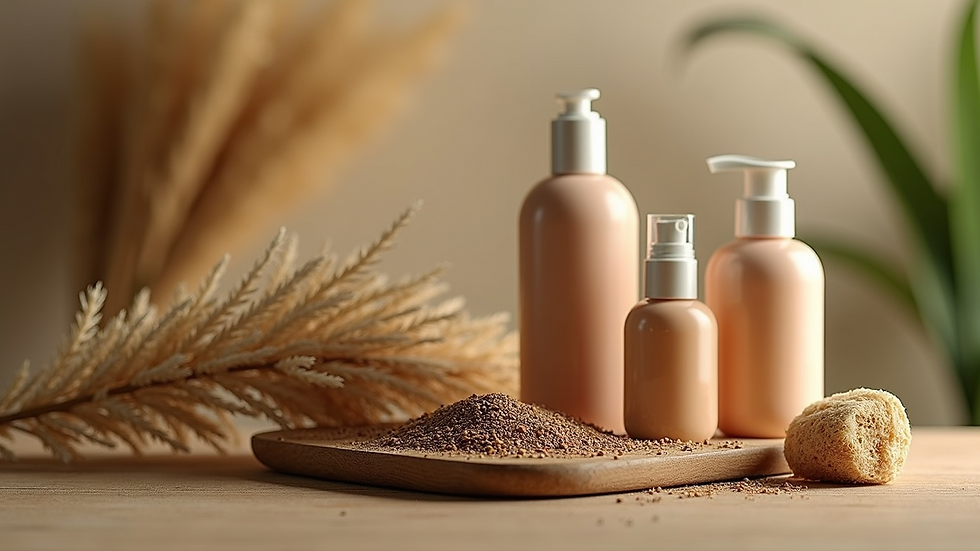Unlocking the Mysteries of Scalp pH: What You Need to Know for Healthy Hair
- Theresa Anthony
- Apr 1
- 4 min read
Are you aware that your scalp's pH level holds the key to your hair's health? Many people overlook the importance of their scalp, focusing solely on styling products and techniques. However, the balance of acidity and alkalinity on your scalp significantly affects how your hair looks and feels. A well-balanced pH can lead to vibrant, shiny hair, while an imbalance may result in dryness, irritation, or even hair loss. In this blog post, we’ll explore the intricacies of scalp pH, its impact on your hair, and practical steps you can take to maintain a healthy balance.
What is Scalp pH?
Scalp pH refers to the acidity or alkalinity of your scalp, measured on a scale from 0 to 14. A pH below 7 indicates acidity, while a pH above 7 indicates alkalinity. For optimal scalp health, aim for a pH level between 4.5 and 5.5, which is slightly acidic. This acidity forms a natural barrier that protects against harmful bacteria and fungi while keeping your scalp hydrated.
When your scalp maintains this ideal pH, hair cuticles lie flat, which enhances shine and reduces frizz. In contrast, if the pH level swings too high or low, it can lead to problems. For instance, a 2019 study found that nearly 50% of participants with scalps outside the ideal pH range experienced changes in hair texture and moisture retention. Such imbalances can provoke issues like dandruff or seborrheic dermatitis, leading to an unhealthy appearance.
Unlocking the Mysteries of Scalp pH: Importance of Scalp pH for Hair Health
Keeping the scalp's pH at the right level is essential for several reasons:
Healthy Follicles: Studies show that a balanced pH promotes healthy hair follicles, preventing clogs that can hinder growth. In fact, a 2020 survey indicated that 60% of participants with pH imbalance reported experiencing hair thinning.
Natural Oils: Sebum is the body's natural oil that moisturizes the scalp. A balanced pH supports optimal sebum production, ensuring that hair remains nourished. Healthy sebum levels can prevent dry hair while increasing gloss.
Dandruff Prevention: A study found that 70% of individuals with pH imbalances experienced scalp dryness and flakiness. By maintaining the right pH, you create a barrier against dandruff formation and other scalp irritations.
Enhanced Absorption: When your scalp is in the perfect pH range, the absorption of essential nutrients from hair care products improves. This allows active ingredients to penetrate better, providing benefits like hydration and nourishment.
Factors Affecting Scalp pH
Several factors can influence your scalp's pH level:
Products: Many popular shampoos and conditioners contain sulfates and alcohol, disrupting natural pH balance. Opt for pH-balanced products that are sulfate-free to minimize this issue.
Diet: Nutrition plays a vital role. Diets high in processed foods and sugars can lead to inflammation that negatively impacts scalp health. For instance, incorporating more whole foods, like fruits and vegetables, can significantly improve scalp conditions.
Environmental Factors: Weather changes, humidity, and pollution can all alter your scalp’s pH. For instance, the harsh chemicals in some swimming pools can dry out your scalp.
Water Quality: Hard water, which is high in minerals, can also affect pH levels. If you have hard water at home, using a water softener or clarifying shampoo can help address this concern.
How to Assess Your Scalp pH
You can determine your scalp's pH level with simple methods like using pH test strips. Here’s how:
Cleanse: Begin by washing your scalp gently to ensure it is free of products. Allow it to dry fully before moving on.
Apply: Take a pH test strip and press it against your scalp for a few seconds.
Read: Refer to the accompanying pH scale to interpret the color change on the strip and assess your scalp’s pH level.
For more precise evaluations, consider visiting a dermatologist or trichologist who specializes in hair and scalp health.
Tips for Maintaining Balanced Scalp pH
To promote a healthy scalp pH, consider these actionable tips:
1. Choose pH-Balanced Products
Invest in shampoos and conditioners that claim to be pH-balanced. Brands that highlight “sulfate-free” formulas are often a good choice, as they are gentler on your scalp.
2. Rinse with Apple Cider Vinegar
By mixing one part apple cider vinegar with four parts water, you can create an excellent rinse. This natural remedy not only restores acidity but can also add shine and help combat dandruff.
3. Limit Heat Styling
Frequent use of heat styling tools strips moisture from your hair and scalp, impacting pH levels. Try to minimize the use of these tools and let your hair air dry whenever you can.
4. Maintain a Healthy Diet
Your scalp is a reflection of your overall health. Consuming a balanced diet filled with vitamins and minerals plays a crucial role. Foods rich in omega-3 fatty acids like salmon and walnuts or fruits high in antioxidants like berries benefit your scalp significantly.
The Connection Between Diet, Lifestyle, and Scalp pH
Your diet and lifestyle choices are directly linked to scalp health. Adopting an anti-inflammatory diet can help maintain your scalp's pH. Consider including omega-3-rich foods, such as flaxseed, and antioxidants found in colorful fruits and vegetables.
Moreover, stress management techniques like yoga, meditation, or regular exercise can positively influence your hair quality. High stress leads to increased cortisol production, which can trigger oil production from your scalp and disrupt the pH balance.
Final Thoughts on Scalp pH
Unlocking the Mysteries of Scalp pH: To achieve luscious, healthy hair, monitoring your scalp pH is crucial. By being mindful of the products you use and incorporating healthy lifestyle choices, you can create the best environment for your hair. Remember, healthy hair starts at the scalp. Embrace these practices and enjoy the benefits of renewed hair and scalp health.




Comments